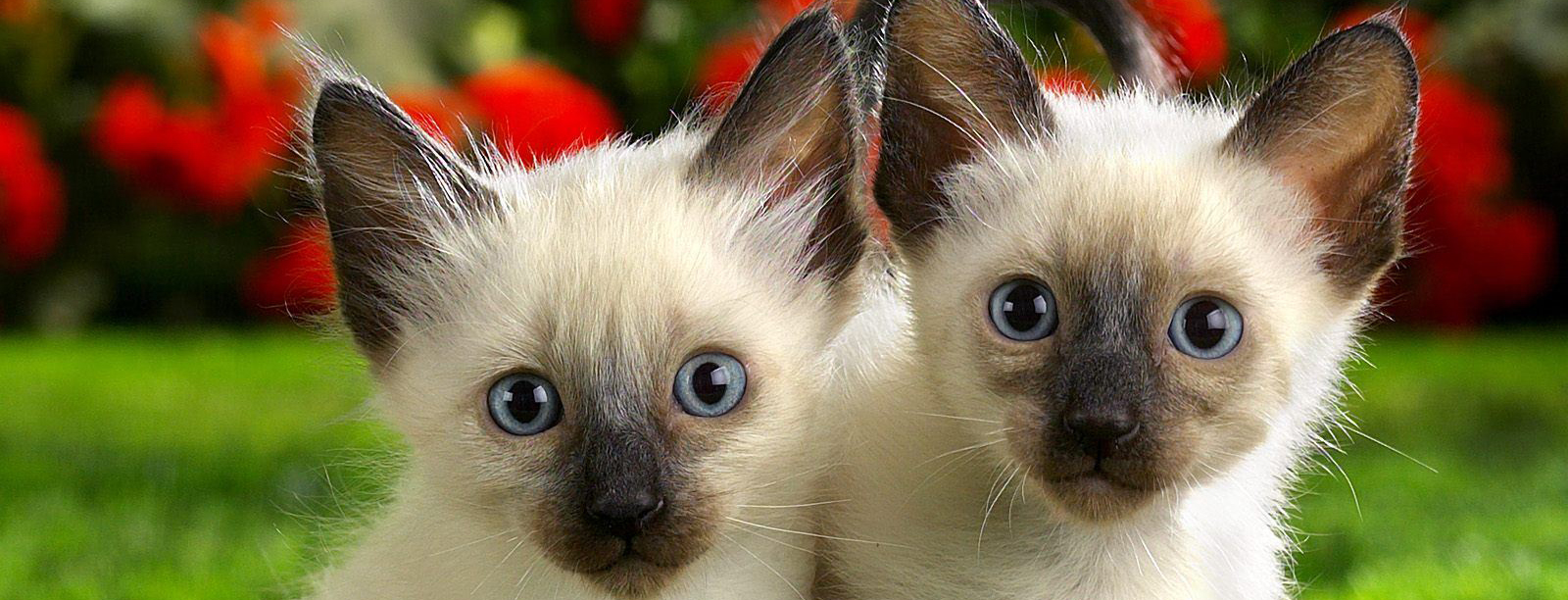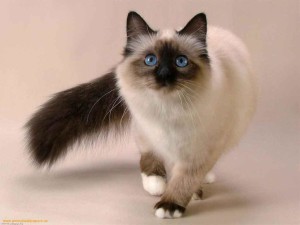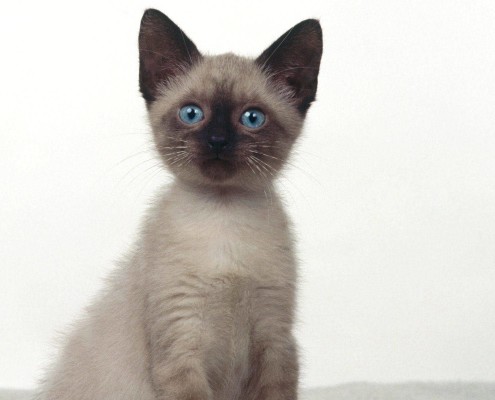Siamese

Meoww!!
Siamese cats may be the world’s most recognizable breed. They are medium-sized with deep blue eyes and a unique thin, tapered, and kinked tail.
In 5 Words
- Vocal
- Lively
- Overtly affectionate
- Caring
- Playful
Snapshot
WEIGHT RANGE:
Male: medium: 8-12 lbs.
Female: small: <8 lbs.
EYE COLOR:
Blue
EXPECTATIONS:
Longevity Range: 8-12 yrs.
Social/Attention Needs: Moderate, High
Tendency to Shed: Low
COAT:
Length: Short
Characteristics: Smooth
Colors: Chocolate, Seal, Lilac, Blue, Red, Cream, Fawn, Cinnamon
Pattern: Points
Less Allergenic: No
Overall Grooming Needs: Low
CLUB RECOGNITION:
Cat Association Recognition:
CFA, ACFA , FIFe, TICA
Prevalence: Common

Characteristics
Learn About the Siamese
Siamese cat breed was first seen outside their Asian home in 1884, when the British Consul-General in Bangkok, Edward Blencowe Gould(1847–1916) brought a breeding pair of the cats, Pho and Mia, back to Britain as a gift for his sister, Lilian Jane Veley (who went on to co-found the Siamese Cat Club in 1901). However, in 1878, U.S. President Rutherford B. Hayes received “Siam”, a gift from the American Consul in Bangkok; this cat was also the first documented Siamese to reach the United States, and predates the Siamese’s arrival in the UK by 6 years.
In 1885, Veley’s UK cats Pho and Mia produced three Siamese kittens. These kittens—Duen Ngai, Kalohom, and Khromata—and their parents were shown that same year at London’s Crystal Palace Show, where their unique appearance and distinct behaviour made an impression. Unfortunately, all three of the kittens died soon after the show. The reason for their deaths is not documented
Wankee, born 1895 in Hong Kong, became the first U.K. Siamese champion in 1898.
By 1886, another pair (with kittens) was imported to the UK by a Mrs. Vyvyan and her sister. Compared to the British Shorthair and Persian cats that were familiar to most Britons, these Siamese imports were longer and less “cobby” in body types, had heads that were less rounded with wedge-shaped muzzles and had larger ears. These differences and the pointed coat pattern, which had not been seen before in cats by Westerners, produced a strong impression—one early viewer described them as “an unnatural nightmare of a cat.”
The first Lilac Point Siamese may have been a cat exhibited in 1896 in Britain that was described as being “not quite blue,” and therefore was disqualified from finishing the competition. The traditional Blue Point Siamese began to acquire a strong following among cat fanciers in the 1930s, which continues to this day. The Red Colorpoint Shorthair caused some controversy when it was first exhibited at cat shows in Great Britain in 1934, because they did not conform to a traditional or even recognized Siamese coloration. Chocolate Point Siamese were not recognized fully in the show ring until sometime in the 1950s.
The Seal Lynx Point reportedly occurred from an accidental breeding of a Seal Point female in 1960, which resulted in one kitten from the litter having tabby markings. Lynx Point Siamese were recognized in Britain in 1966. there have been many theories about the origin of the Siamese, many breeders acknowledge that it came from the ancient Siamese city of Ayudha. The original cats lived in temples and were thought to have “special powers”. Ownership was also restricted to members of the Royal Family, hence it was known for hundreds of years in its own country as the “Royal Cat of Siam”.
Siamese cats may be the world’s most recognizable breed. They are medium-sized with deep blue eyes and a unique thin, tapered, and kinked tail. Their most distinguished feature, however, is their coat pattern. The majority of the Siamese’s body is light colored. But pointing, or a darker coat pattern, covers the muzzle, legs, and tail. Traditionally, Siamese cats are divided into two groups: traditional or extreme. The rare traditional Siamese boasts a rounder head and a body with heavier form. By contrast, the extreme Siamese has a wedge shaped head and a very slender, elongated body. The coat of both forms is short and glossy.
The face, paws, ears & tail (points) have a darker colouring, the body is light in colour. The coat should be short, fine & silky to the touch. The ears are large, eyes are a stunning blue & almond shaped. Some also have tabby or tortie markings as well. The rest of the body is cream or off white and may develop some tonal shading as the cat gets older. Tonal shading is usually more obvious in the darker colours such as seal and chocolate points.
The Siamese personality is vocal, lively, and overtly affectionate. The breed can be very demanding and should not be left alone for long periods of time. Daily play and interaction are critical to a Siamese’s emotional and mental well-being. Active feline companionship will help keep a lonely Siamese happy, but there is no substitute for human interaction as well. They are very playful, entertaining themselves for hours. They have their favorite toys and never tire of playing throughout their lives. They are natural fetchers and will fetch as long as someone is there to toss! They are very amusing pets.
They love to pile up in a heap, whether it is in a lap or in front of the fridge to soak up the warmth or in a kitty kozy. They are as likely to crawl under the covers and snuggle as they are to curl up in a warm windowsill. They LOVE warm places. Siamese need to be treated with respect and patience and require lots of affection if they are to develop a close, caring relationship with their human companions. Siamese will pine if left too often alone.
Siamese occasionally have problems with crossed eyes or a kinked tail. Other problems reported in the breed include bladder stones; eye problems like glaucoma and progressive retinal atrophy; heart problems; and certain types of cancer.
Siamese cats are very low maintenance, easy cats to care for, their close lying coats need little grooming, a gentle brush every few days or stroking with damp hands will remove dead hair.






